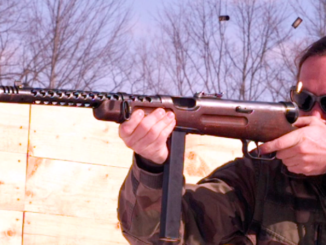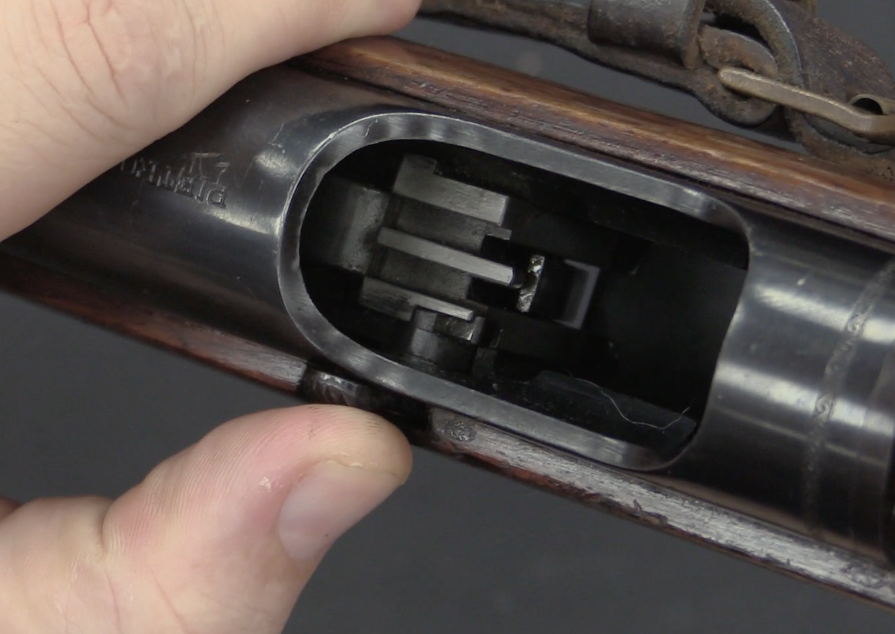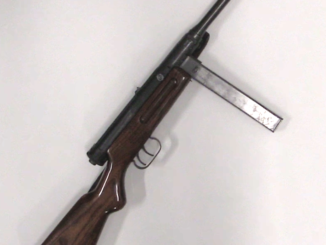When the Italian military was looking for a new sidearm in the early 1930s, they really liked the pistol submitted by Beretta – but they also really liked the Walther PP. During the development process, the military requested that Beretta add a Walther-style slide-mounted safety to the Model 1934. That is the model that Beretta began making for the initial military trials contract of 650 guns, but partway through they were told to drop it (much to the relief of Beretta engineers, I expect). As a result, only a few hundred of these early dual-safety models were made.
Related Articles

Slow motion
Italy’s Sleeper Submachine Gun: The Beretta 38A
The Beretta 38A is not a gun that comes to mind for many people today when discussing World War Two submachine guns, but at the time it was one of the most desirable guns of […]

Semiauto Rifles
RIA: Beretta 1918/30 Semiauto Carbine
The Model 1918/30 is a semiauto-only carbine made by Beretta in between the early Model 1918 submachine guns and the excellent Model 38 family. It was marketed (well, sold) primarily to security and police forces, […]

Submachine Guns
Beretta 38/42: Simplified But Still Excellent
The Beretta Model 38A was an outstanding SMG at the beginning of World War Two, loaded with features and very easy to shoot. However, it was expensive and complex to produce, and pressures of war […]

Pocket guns like this were really popular with the officer corps in the old days. Light and handy enough to carry yet persuasive enough to keep unfriendly folks at bay. How valuable are the early 1934 production models?
May it be that they serve more to intimidate your own underranks ?
Assuming you are addressing people who would shuck off their gear and uniforms and then hide under haystacks or behind tombstones for fear of magically receiving sniper fire to the head from two miles away, perhaps you would have to scare them straight. “Why they couldn’t hit an elephant at this distance!” Just kidding!
That would go along nicely with my Beretta made m38 Calvary carbine.
Also known as a Golgotha carbine.
I’ve got a 1941 made Model 34 (without this double safety). I fired it with .380 FMJ last month. It’s marked with the Roman Numeral XIX for the nineteenth year of the Mussolini era, also “9mm Corto” for 9mm Short / 9mm Kurz / .380 – it’s pleasant to shoot. A nice little pistol.
I like how Ian pretends Beretta’s grossing: “…maddona mia, sicura germanica sulla pistola italiana!” 🙂
I was on the edge of my seat waiting for the slide safety to turn out to be a decocker too, because absolutely nothing surprises me anymore.
Not related to the weapon at hand, but I just had to post this. Ian’s book arrived today, and it is gorgeous. Ian, you did a wonderful job. None of the online posts and updates do it justice; I can’t wait to take a deeper dive and learn all there is to know about French rifles!
Cheers,
Tod
Even today, there are automatic pistols with slide-mounted safeties that look like a Walther decocker but operate like this.
Some are cheap, like the Zastava M88A;
https://www.handgunsmag.com/editorial/tempted-by-tokarev/137733
Some are anything but, like the Desert Eagle;
https://rangehot.com/desert-eagle-dual-personality/
Generally, their one claim to logic is that the slide can be racked to load the chamber with the safety on. By comparison, a 1911-type thumb safety has to be off for the slide to even move. Which means that a Browning-type automatic with such a safety is “hot” as soon as the chamber is loaded, until you re-engage the thumb safety, unless it has a separate grip safety as Ian discussed the other day.
Hm. Seen in that light, the grip safety on the 1911 suddenly makes more sense, and not just for cavalry. Even a pistol with a magazine disconnector safety, like the FN High Power, is “ready to fire” when the chamber is loaded from the magazine, since of course it releases the magazine safety when seated.
Of course, if you are gripping the 1911 correctly to rack the slide, which requires a firm grasp of the butt to resist the torque, you’ve also automatically disengaged the grip safety.
The ergonomics of the Walther-type safety are easy to understand. It sits right above the shooter’s right thumb and is disengaged with an upward movement of same. On a relatively small pistol like a Walther PP or PPK, or even a medium-sized one like a P.38 or Beretta M9, this isn’t too difficult to accomplish. (NB: I have owned and carried all of the above, both on and off duty, in my time.) Some do require longer thumbs than others to reach, notably the M9.
On truly large pistols like the Desert Eagle, you’d better have a thumb like an orangutan. Or do what I did; trade it in on a S&W M27.
Far from being “An ingenious answer to a non-existent problem” as Jeff Cooper once called the Walther decocker, the slide-mounted safety is one more proof that there is really no fully-satisfactory safety on any self-loading pistol. (No, not even the Glock and similar “Steyr 1908”- type systems.)
Anyone for a double-action revolver?
cheers
eon
“Anyone for a double-action revolver?”(C)
May I?!!
With all the technical superiority of an auto pistol over a revolver, in terms of reliability, the oldest revolver is still better than the most modern pistol.
Especially modern. 😉
Beretta 34 very good pistol, except for the lack of double action.
I’ve seen somewhere with a dozen of these at the warehouse preparing for disposal. All with medium to heavy wear. All of them were practically serviceable, except for cracks in the plastic of the handle and disappearing rifling in the barrel. All of them worked properly and if you did not look inside the barrel (except for two rusted outside) they did not even look very worn out.
Even though it’s not double-action, the Colt Peacemaker type single-action revolver is still probably the most reliable repeating firearm ever made. Simply because there just isn’t much that can go wrong.
The only real weak point in the Colt design is the hammer mainspring, that can break at the attachment point at the very bottom of the grip frame, where it is secured by a screw. The fix for this is simply to put a soft buffer about 3/32″ thick (about 2.5mm) between the frame and the spring around the screw. Most Westerners used a small piece of soft leather back in the day; today, nylon or some synthetic fiber would work as well.
Better yet, get a Ruger single action with coil springs throughout.
And of course, always keep an empty chamber under the hammer.
😉
cheers
eon
In my opinion, the original design of the Colt SAA has long been not only not done, but no longer buried.
In some ancient repair manual, reference was made to such typical (for this model) malfunctions as a failure of synchronization due to wear of parts of the trigger group and a loose ejector tube.
You’re referring to the classic “timing” problem, which means that the cylinder lockup has the firing chamber imperfectly aligned with the barrel forcing cone.
This is a problem inherent with any revolver, and is an effect of excessive wear, usually of the hand or cylinder stop. The standard treatment is to replace one or both. Either that, or replace the cylinder if the excessive wear is on the stop notches or the rotator ratchet.
I’ve never heard of a problem like that due to a loose ejector housing. A weak spring on the ejector rod can cause it to slip backward into a chamber mouth and tie up the cylinder, but that’s pretty rare. The treatment of course is to replace the ejector rod return spring.
As for a loose ejector assembly, that’s generally due to a worn or even broken-off screw stud on the barrel at the front of the ejector tube. What usually happens at that point is that the ejector assembly falls off when the revolver is held muzzle-down. Or else it gets left in the holster during a fast draw. The cure is of course to fix the securing screw stud.
As for rotation problems due to a “tube”, that would be what’s known as “end shake” in the cylinder brought on by a worn cylinder base pin bushing, which is actually a tube going right through the middle of the cylinder. Wear on it can cause the cylinder’s front face to drag on the back end of the barrel. The standard treatment is to replace the bushing tube.
Yes, I’ve gone round and round with the Colt a few times.
cheers
eon
I am grateful to learn about this truly forgotten weapon.
I like the Beretta 1934, which is a handy and reliable little pistol. However, the safety catch on the frame is impossible to use with the thumb of your right hand, you really need your left hand to operate it, without having to twist the gun round in your hand. Also, this safety only operates on the trigger, not the hammer.
I found it much easier to use the half cock notch rather than the frame mounted safety on the 1934, and did not feel unsafe doing so. However a slide mounted safety which blocked the hammer would have been a useful addition. I can see that Beretta would not have been happy rejigging their finished design to accommodate this, but with the 1951 they did go with a slide mounted cross bolt safety, and they kept the slide mounted safety with the M92, so they must have seen the sense in this arrangement eventually.
Hm. All the M1951s I’ve ever dealt with had either a crossbolt safety at the top rear of the grip (before 1970) or a 1911-type thumb safety in the traditional 1911 position (post-1970).
The first full-production Beretta with a Walther-type safety was the Beretta Model 92S, introduced in 1977. The original M92 introduced in 1976 still had a 1911-type safety. This version was later produced in Brazil as the Taurus PT-92, in a plant originally created for the Brazilian government by Beretta.
Even the rare Beretta Model 90 (about 25,000 made from 1969 to 1971), Beretta’s first double-action automatic intended to compete with the Walther PP, still had a frame-mounted 1911-type safety.
cheers
eon
Eon:
You are right, the 1951’s cross bolt safety was on the frame, not the slide. But it was behind the grip, where it could be operated by the right hand thumb. The position of the 1934’s safety forward on the slide really is too difficult to reach for the right hand thumb without twisting the pistol around in the hand. Hence it is easier to use with the half cock notch. A slide mounted safety would have been better than the safety in the position Beretta put it on the 1934, but I can understand why Beretta did not want to change a finished design to do this.
The original 92 had a frame mounted safety. Then the Italian Police told Beretta that a SA/DA service pistol needed a decocker (because it’s “natural” way of carry was in condition two, while for a SA-only it was condition three). Only at that point Beretta went for the safety/DECOCKER on the slide.
“decocker” is in capital because it’s the only reason the lever is on the slide. That’s infact the safest place to put a decocker. A decocker on the slide can decock the hamemr completely, since it rotates the firing pin out of the way of the hammer while doing so. Frame-mounted decockers only decocks to half-cock, so leaving a gap for debris to enter.
“You’re referring to the classic “timing” problem”(C)
I don’t remember what exactly was there.
I’m not very interested in revolvers, it was a long time ago, and SAA saw only a modern clone.
But there the conversation was about a specific bug specific to this model.
Something related to the not quite correct use of the trigger.
the yellow is probably from the light bulb above you warming up still. it takes them a little bit to get to full brightness/luminosity.